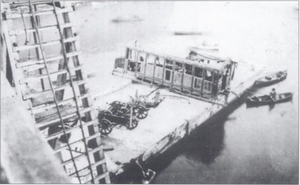Madison Street Bridge disaster

The streetcar Inez raised after falling into the Willamette River
|
|
| Date | November 1, 1893 |
|---|---|
| Time | 6:45 a.m. |
| Location | Portland, Oregon |
| Coordinates | 45°30′48″N 122°40′16″W / 45.5134°N 122.6712°WCoordinates: 45°30′48″N 122°40′16″W / 45.5134°N 122.6712°W |
| Rail line | East Side Railway |
| Type of incident | Streetcar ran off open drawbridge into river. |
| Cause | Excessive speed, poor warning systems, icy track. |
| Statistics | |
| Passengers | 18-20 |
| Crew | 2 |
| Deaths | 7 |
| Damage | Streetcar Inez destroyed. |
The Madison Street bridge disaster occurred on November 1, 1893, in Portland, Oregon, United States, when a westbound streetcar drove off the open draw of the first Madison Street Bridge (since replaced by the Hawthorne Bridge). Seven people died. This remains the worst streetcar accident ever to occur in the city of Portland and also the worst bridge disaster in Portland history.
Opened in January 1891, the first Madison Street Bridge was a swing bridge which pivoted on a large central trunnion mounted on a piling structure in the river. The bridge was poorly designed. At the time of the accident, the bridge was owned by the City of Portland.
On November 1, 1893, in foggy weather after dawn, the sternwheeler Elwood approached the bridge, and gave the signal to open the draw, one long and three short blasts on the steam whistle. To allow the steamer to pass, the bridge operator swung open the swinging draw section of the bridge. The bridge tender closed the wooden gates on each side of the draw and hung a red signal light as a warning.
At about 6:45 a.m. on November 1, 1893, the streetcar Inez, owned by the East Side Railway Company, arrived at the Madison Street Bridge, running westbound into the city with 18 to 20 passengers on board, as well as the motorman and the conductor. All the streetcars were named in those times. Inez was coming from Milwaukie. Some passengers got off, and one witness said there were about 15 passengers on board when the car reached the bridge. The night before had been cold and frost covered the rails. The car had departed from Oak Grove at about 5:55 a.m. that morning.
Policeman J. J. Flynn, whose post was on the east side of the bridge, stated that he had seen the streetcar pass and had thought it was running somewhat fast, but he paid not too much attention to it. His job was to make sure that carts and horse-drawn vehicles slowed to a walking pace when crossing the bridge. However, he had received no instructions as to speeds of the trolleys. His statement concluded, however: "I think the car was running too fast."
...
Wikipedia
